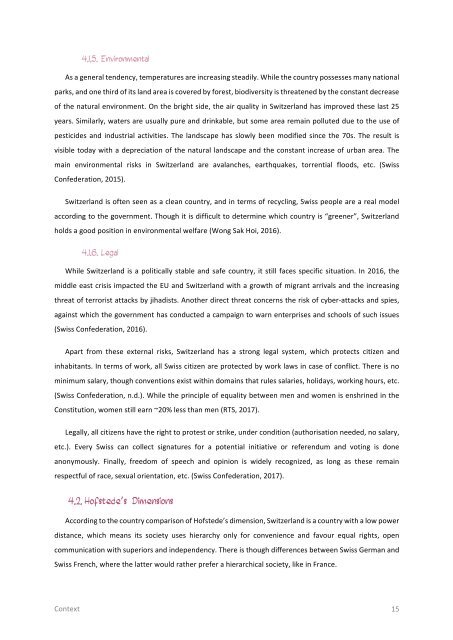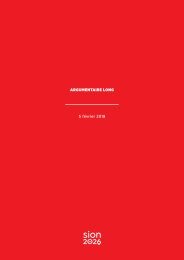Reviving the Flame
Travail de Master de Tiffany Duc
Travail de Master de Tiffany Duc
Create successful ePaper yourself
Turn your PDF publications into a flip-book with our unique Google optimized e-Paper software.
4.1.5. Environmental<br />
As a general tendency, temperatures are increasing steadily. While <strong>the</strong> country possesses many national<br />
parks, and one third of its land area is covered by forest, biodiversity is threatened by <strong>the</strong> constant decrease<br />
of <strong>the</strong> natural environment. On <strong>the</strong> bright side, <strong>the</strong> air quality in Switzerland has improved <strong>the</strong>se last 25<br />
years. Similarly, waters are usually pure and drinkable, but some area remain polluted due to <strong>the</strong> use of<br />
pesticides and industrial activities. The landscape has slowly been modified since <strong>the</strong> 70s. The result is<br />
visible today with a depreciation of <strong>the</strong> natural landscape and <strong>the</strong> constant increase of urban area. The<br />
main environmental risks in Switzerland are avalanches, earthquakes, torrential floods, etc. (Swiss<br />
Confederation, 2015).<br />
Switzerland is often seen as a clean country, and in terms of recycling, Swiss people are a real model<br />
according to <strong>the</strong> government. Though it is difficult to determine which country is “greener”, Switzerland<br />
holds a good position in environmental welfare (Wong Sak Hoi, 2016).<br />
4.1.6. Legal<br />
While Switzerland is a politically stable and safe country, it still faces specific situation. In 2016, <strong>the</strong><br />
middle east crisis impacted <strong>the</strong> EU and Switzerland with a growth of migrant arrivals and <strong>the</strong> increasing<br />
threat of terrorist attacks by jihadists. Ano<strong>the</strong>r direct threat concerns <strong>the</strong> risk of cyber-attacks and spies,<br />
against which <strong>the</strong> government has conducted a campaign to warn enterprises and schools of such issues<br />
(Swiss Confederation, 2016).<br />
Apart from <strong>the</strong>se external risks, Switzerland has a strong legal system, which protects citizen and<br />
inhabitants. In terms of work, all Swiss citizen are protected by work laws in case of conflict. There is no<br />
minimum salary, though conventions exist within domains that rules salaries, holidays, working hours, etc.<br />
(Swiss Confederation, n.d.). While <strong>the</strong> principle of equality between men and women is enshrined in <strong>the</strong><br />
Constitution, women still earn ~20% less than men (RTS, 2017).<br />
Legally, all citizens have <strong>the</strong> right to protest or strike, under condition (authorisation needed, no salary,<br />
etc.). Every Swiss can collect signatures for a potential initiative or referendum and voting is done<br />
anonymously. Finally, freedom of speech and opinion is widely recognized, as long as <strong>the</strong>se remain<br />
respectful of race, sexual orientation, etc. (Swiss Confederation, 2017).<br />
4.2. Hofstede’s Dimensions<br />
According to <strong>the</strong> country comparison of Hofstede’s dimension, Switzerland is a country with a low power<br />
distance, which means its society uses hierarchy only for convenience and favour equal rights, open<br />
communication with superiors and independency. There is though differences between Swiss German and<br />
Swiss French, where <strong>the</strong> latter would ra<strong>the</strong>r prefer a hierarchical society, like in France.<br />
Context 15





